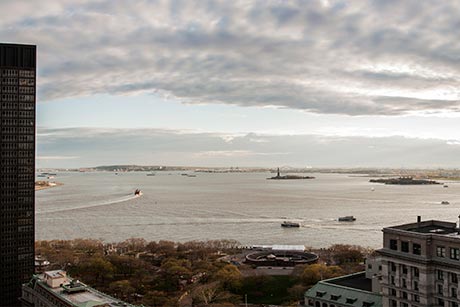Bird’s-eye view of NYC for Architecture, Art and Planning
By Daniel Aloi



The College of Architecture, Art and Planning’s New York City program (AAP NYC) now has a new home at 26 Broadway, a historic landmark overlooking lower Manhattan.
Occupying more than 11,000 square feet of former boardroom space on the entire 20th floor of the Standard Oil Building, AAP NYC will host graduate and undergraduate students in architecture, planning, fine art and landscape architecture, as well as professional education programs and public programming.
“AAP’s New York City program offers our students a deep, informed and direct exposure to urban issues that we simply cannot provide on the Ithaca campus,” said Kent Kleinman, the Gale and Ira Drukier Dean of AAP. “Given the urbanization of the world’s population, our expansion in the city represents not just bigger and better space, but a fundamental shift in our curriculum toward one of the world’s most interesting and urgent challenges.”
AAP is launching its first executive education program in the city this summer, tailored to international architecture and urban design professionals and taught in collaboration with top New York City-based design firms, Kleinman said.
About 250 alumni, friends and students attended a reception at 26 Broadway March 23.
“There was a lot of enthusiasm from alumni who came to see the space,” said Susan Christopherson, professor and chair of city and regional planning. “It’s not just a beautiful space, it’s a functional space. It’s going to provide us with more intellectual presence in the city. When people come to this place they will get a very different impression of Cornell and AAP in New York.”
The newly renovated site features gallery space, a multi-use room for lectures and public events, and expanded studio and classroom area for students, who moved March 27 from AAP NYC’s former home of almost nine years, at 50 W. 17th St.
The city offers myriad opportunities for immersive experiences in learning, research, engagement and problem-solving – including tackling complex urban design issues in a major metropolitan center.
“For all of our students – graduate and undergraduate and across disciplines – New York City is a laboratory and a muse,” said Robert Balder ’89, AAP NYC executive director. “Professionally the city continues to be an international hub of design and fine arts, and as a rapidly changing urban center the full life cycle of major city planning and development projects play out every day. Students immersed in this environment are forever changed.”
The site will be home to about 50 AAP students taking classes each semester. The floor plan “subdivides the space quite effectively,” said Mark Cruvellier, professor and chair of architecture. “Before, we had everybody on top of each other; there is now dedicated space.”
The facilities renovation was spearheaded by Gensler, a design firm led by Arthur Gensler, B.Arch. ’57. The space was customized to meet the range of AAP’s programming needs and is adaptable for various uses during and between semesters. Its natural lighting and 360-degree views enhance the experience of the city as an extension of the classroom.
“It’s going to be wonderful for events, a place where we can have forums on the smart city and other kinds of real public engagement – events that make Cornell visible in New York City,” Christopherson said. “All in this very dramatic setting – you can look out the window and see the Statue of Liberty.”
The program also offers access to professional training and internship opportunities, cultural resources, city agencies and community organizations.
“A lot of architecture offices are now down in what has long been known as the financial district, within literally a block or two of where we are,” Cruvellier said.“We’ll beinteracting with these offices directly, either through having them teach here or dropping in for critiques or reviews.”
Designated a New York City landmark in 1995, 26 Broadway housed Standard Oil’s headquarters from 1885 to 1956. From 1917 to 1937, Walter Teagle, Cornell Class of 1899, was president of Standard Oil of New Jersey, then the largest of the parent company’s petroleum operations, and led Standard Oil’s growth following World War I.
Media Contact
Get Cornell news delivered right to your inbox.
Subscribe